Stewart Ranch Services
Bowie, Texas
Beaumont Excavation Services in Beaumont TX
DESIGN YOUR DREAM
PROPERTY
LAND
ACREAGE
DEVELOPMENT SITE
POND
Beaumont Excavation Services
When starting a building project in Beaumont, Texas, the importance of proper excavation cannot be overstated. It forms the basis for strong foundations and effective drainage systems. This guide offers a comprehensive view of construction design for excavation work, encompassing its integration into the overall project plan, equipment selection, and the unwavering commitment to safety measures.
Collaborating with a seasoned Beaumont excavation service provider and accounting for environmental factors are pivotal steps in ensuring your project’s success, delivering a solid foundation and dependable drainage.
Key Takeaways
Table of Contents
Understanding Excavation in a Construction Site
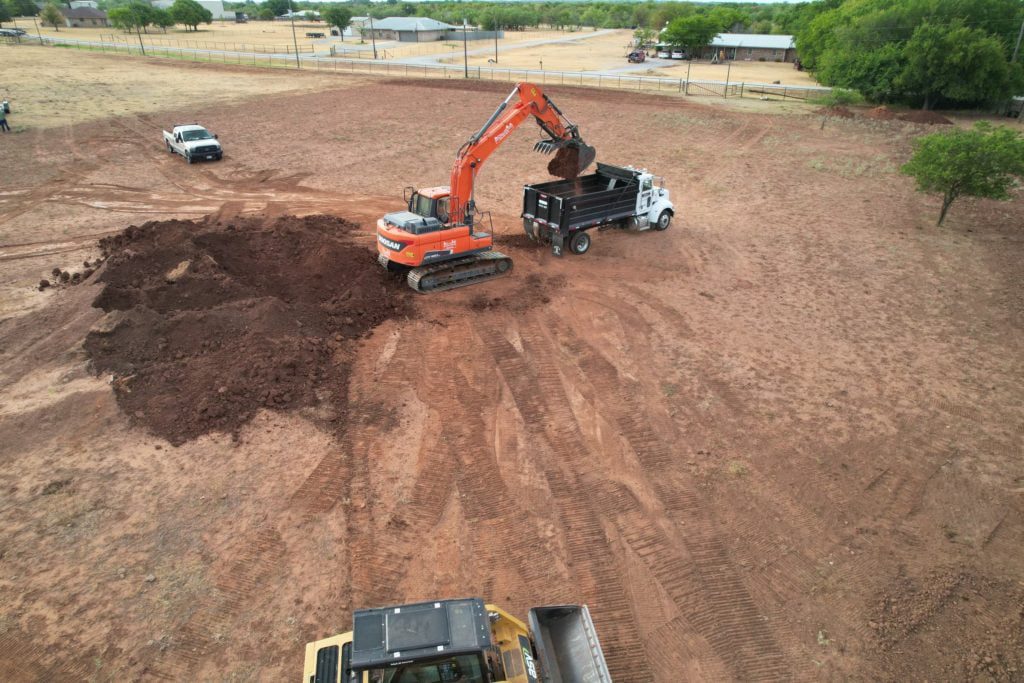
When tackling construction and landscaping projects, excavation emerges as a pivotal process that reshapes the land and lays the groundwork for future developments. This necessitates the removal of earth, stones, and other materials from the construction site to facilitate landscape grading, a crucial step in the grading process.
To accurately estimate the costs of grading, one must consider factors such as lot size and the need for drainage solutions near adjacent properties. The term “finish grading” signifies the final touches applied to the land’s surface.
Whether it involves excavating trenches for walkways, sidewalks, or even pool installations, excavation resources are instrumental in establishing strong foundations that harmonize with the project’s overarching objectives.
Types of Excavation Methods
Construction projects often rely on various excavation techniques, including cut and fill, trenching, and dredging. Cut and fill, for instance, is the process of removing soil to create a level surface, a crucial step in site grading. For architectural grading and the foundation of any construction project, we use high-quality asphalt made from aggregate and a binder, ensuring a solid base.
Trenching, on the other hand, is essential for landscape construction, allowing us to bury cables and pipes below the surface. Dredging is another service we offer, involving sediment removal from nearby water bodies, particularly in cases where they may impact the home building process.
At Stewart Ranch Services, we bring the latest technology to your project, delivering top-notch excavation services in Beaumont, Texas.
Factors Affecting Excavation
In the context of Beaumont excavation services, it’s vital to consider several factors, including soil type, weather conditions, and the size of construction projects. Soils with a high clay content are preferred for creating a robust foundation. Rapid, field-based assessments such as ribbon tests are used to determine soil suitability quickly.
Weather elements like rain, snow, wind velocity, and extreme temperatures can have a significant impact on the grading process in excavation projects. Additionally, projects that demand more equipment and personnel, such as landscaping assignments, typically result in increased costs due to extended timelines and project duration estimates.
Beaumont Excavation Services - Essential Equipment
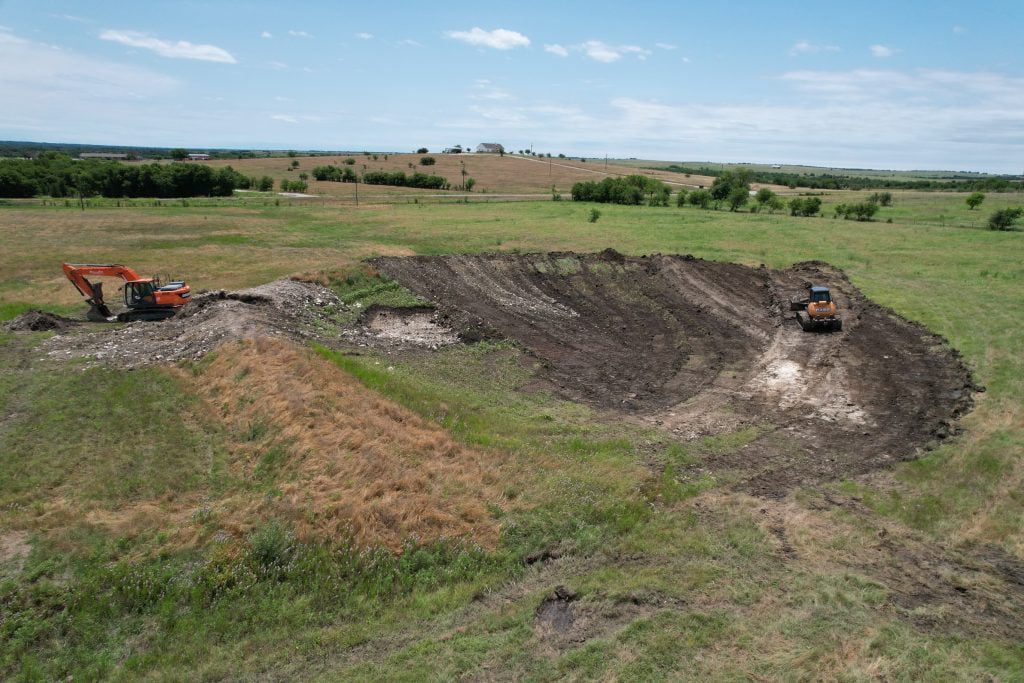
In the realm of Beaumont excavation services, the utilization of heavy equipment is indispensable. Excavators, bulldozers, and loaders are the workhorses of the construction industry, facilitating the movement of soil and materials to shape the land and create the necessary grade.
These machines are complemented by various attachments, such as buckets, blades, and rippers, which offer flexibility in achieving the desired finish for construction activities.
Excavators
Excavators, with their characteristic boom, bucket, and cab mounted on a rotating platform, are fundamental to the construction industry. These versatile machines are the backbone of construction sites, enabling precise grading by excavating substantial amounts of soil and materials required for building projects.
From crawler excavators designed for heavy material lifting to wheeled diggers suitable for excavation tasks and mini-excavators tailored for smaller projects, the diversity of excavators meets various construction needs.
Safety measures should always be a top priority in excavator operations. Operators must wear the appropriate safety gear, follow stringent safety protocols, and employ trench boxes and shoring systems when necessary while operating this heavy-duty equipment.
Bulldozers
Bulldozers are essential in road construction, agriculture, and mining operations for efficiently managing substantial quantities of materials. These powerful machines are equipped with a sturdy metal blade at the front, purpose-built for tasks like pushing, excavating, digging, and leveling soils, as well as transporting construction materials.
Safety is a top priority when operating bulldozers. Operators should always wear hard hats with safety glasses and steel-toed boots to ensure their safety on any construction project.
Compliance with safety protocols is not just a formality but a critical requirement to guarantee the optimal performance of these heavy machines while safeguarding the well-being of all individuals involved. Loaders excel in material handling tasks, and the rear-mounted device empowers operators to undertake various excavation projects, including trenching activities. To ensure the safe usage of this equipment, workers should undergo comprehensive safety training, conduct regular machine inspections before deployment, and consistently wear the necessary protective gear during onsite work.
For all your heavy equipment needs, Stewart Ranch Services is the go-to choice. We provide a diverse range of machinery to meet your construction project requirements.
Beaumont Excavation Service Process: Step-by-Step
The journey of constructing a building is marked by several distinct phases, starting with the evaluation and meticulous planning of the construction site. Initially, the creation of an accurate site grading plan takes precedence, with the goal of optimizing the efficient use of existing materials, leading to cost savings during the grading and construction phases.
Following this, the site is prepared for construction through the removal of vegetation, debris, and other obstructions. Excavation and site grading activities are then executed to establish a stable foundation by excavating and leveling the ground, followed by fine-tuning through finish grading.
To bring the construction project to its conclusion, utilities such as pipes are set in place, and drainage systems are installed, with the final step involving the placement of asphalt or concrete pavements, marking the completion of this developmental phase for the specific site.
Site Preparation for a Solid Foundation
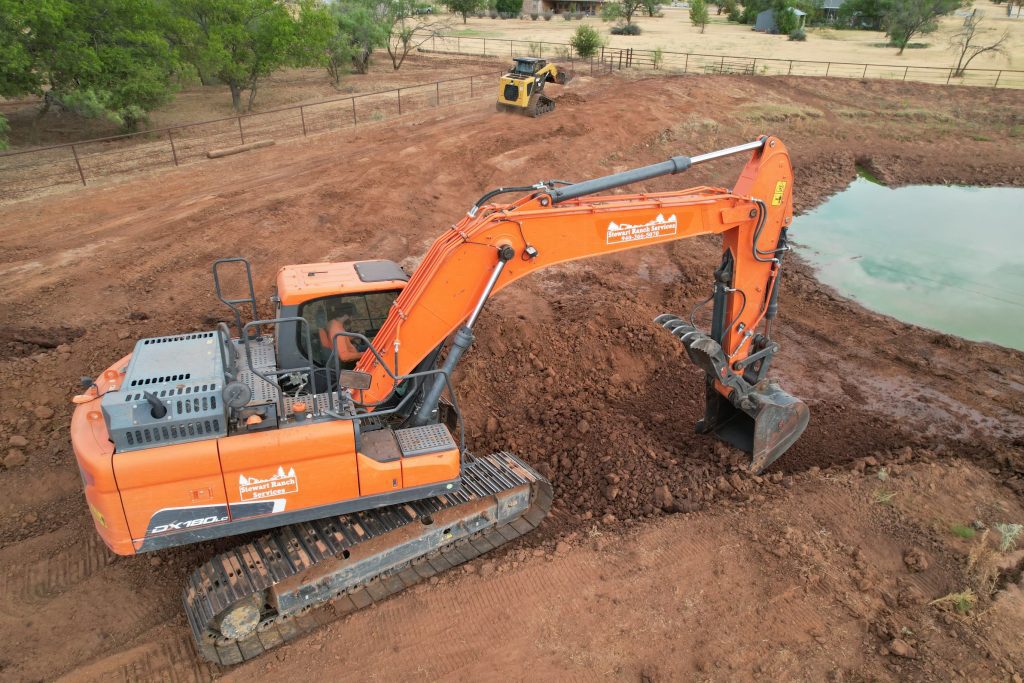
Site preparation is a vital precursor to a successful construction project. It starts with land clearing, which entails the removal of trees, shrubs, and other vegetation to ensure safety and create space for the intended project.
The next step is excavating and transporting the topsoil offsite, a process that not only generates space but also ensures that the soil conditions at the construction site are conducive for development. It’s imperative to identify and mark any underground utility lines before starting work to prevent disruptions.
Additionally, removing a few inches of topsoil is crucial for establishing a solid foundation.
Excavating and Site Grading process
The process of excavation and rough grading plans are essential for the successful completion of construction projects. This involves digging up soil, leveling it off, as well as moving and grading other materials with specific equipment such as excavators, bulldozers or backhoes.
Finished Grade: for some purposes such as earthworks projects and gravel roads, grading extends to include the cover and surface of the finished construction, not just the base. In landscaping projects, finish grading means to finish the final contour of the projects, shaping the selected area to prepare for sodding, seeding, or planting. Finish grading includes putting the final touches on the grading projects.
The primary objectives of site grading includes: Ensuring a proper drainage system, getting the property’s desired aesthetics, reducing environmental impact by ensuring water runoff and reducing erosion and pollutants.
Changing the contours of a land area for a commercial property, housing development or new home typically means changing the contours of the landscape to take out unwanted elevation, accommodate proper drainage, and get the foundation areas ready.
Ensuring proper techniques while doing this type of work is important in order to avoid potential problems like drainage issues or erosion down the line when working on a building structure or roadway foundation.
It is also useful in preventing any future complications during construction since it makes sure that everything runs smoothly from start to finish on-site by setting up an appropriate base before beginning work.
At Stewart Ranch Services we take care of everything: from site preparation and land clearing to excavation services in Beaumont, Texas.
Backfilling and Compaction
In the pursuit of stability within an excavation project, the backfilling and compaction of excavated areas are paramount. After the excavation phase is complete, it is essential to fill the void with soil or other suitable materials, which are then compacted to increase density and protect against erosion and potential collapse.
The use of heavy machinery, such as bulldozers and backhoes, is often necessary to carry out these tasks effectively. Safety measures, including wearing appropriate gear and adhering to safety protocols, should never be overlooked.
Disregarding safety regulations or neglecting proper backfilling and compaction procedures can compromise the long-term structural integrity of the excavation project.
Safety Measures in Excavation Projects
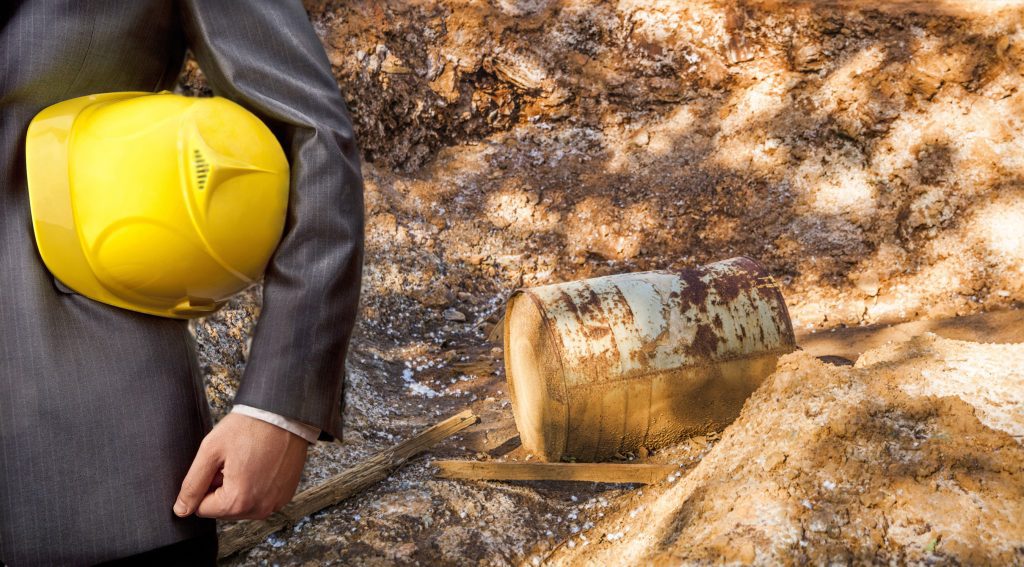
When engaging in any excavation project, safety is of the utmost importance to prevent accidents and potential harm. Establishing a secure work environment involves taking appropriate precautions, such as wearing protective attire like hard hats and safety glasses for eye protection.
Gloves and steel-toe boots should be worn by all personnel when close to excavation sites. Comprehensive training in equipment operation is a necessity. Regular inspections, along with conspicuous warning signs and the use of barricades around dangerous areas, are crucial.
Trench and Excavation Safety

Ensuring the safety of trenching and excavation projects, especially within the excavation service sector, is a top priority. Comprehensive planning is the cornerstone of this safety effort, enabling the identification of potential risks and the development of strategies to mitigate them. This planning ensures that Beaumont excavation service projects are in full compliance with local regulations and maintain the highest safety standards.
To protect both workers and the project itself, various protective measures, such as shoring to prevent cave-ins, barricades to shield personnel from falling objects, and sloping to reduce the risk of collapse, are utilized during trenching and excavation operations.
Regular, systematic inspections are conducted to promptly identify potential hazards and confirm adherence to security protocols throughout the entire project, from initial excavation to completion.
Protective Systems
In order to protect personnel during excavation projects from potential cave-ins and soil failures, the use of protective systems is essential.
These consist of: benching, which involves creating steps or benches in the walls, sloping where you angle the walls for additional safety precautions. Another method is shoring, or utilizing supports like hydraulic jacks as well as beams for added security. Lastly, shielding includes employing trench boxes or other similar structures to provide a barrier between individuals and any excavated area’s sides.
All these measures need to be implemented correctly so that they can work adequately towards promoting an environment that ensures employee protection against dangerous occurrences.
Shoring makes use of mechanical methods including support frameworks, while with shields, people are offered adequate coverage from both falling objects and collapses in soil concerning elements within a dug up space’s surrounding exterior.
Beaumont Excavation Services - Hiring a Professional Excavation Contractor

When it comes to your construction project, securing the services of a skilled Beaumont excavation service contractor is pivotal. With their expertise, equipment, and experience, they can tackle excavation work with speed and safety.
It’s essential to make an informed choice by examining their past experience, reputation for reliability, safety performance, and the level of customer service they offer.
Qualities to Look For
When selecting an excavation contractor, it is essential to assess their skill set. Highly trained personnel with the right qualifications and certifications are crucial for ensuring safety and competence during excavation projects.
It’s equally important to scrutinize their reputation by checking client reviews and evaluating their past excavation projects.
Experience is a valuable asset, as it allows the contractor to offer reliable project timelines and effectively address any unforeseen issues that might crop up during the excavation process.
Questions to Ask Before Hiring
Prior to engaging an excavation contractor’s services, it’s essential to pose a series of questions to make an informed decision. Consider discussing the following:
- The excavation contractor’s industry experience.
- Their commitment to safety protocols.
- The customer service standards they uphold.
- Confirmation of proper licensing and insurance.
- The equipment they intend to employ.
Companies with skid steers and mini excavators often attempt projects that should be handled by dozers and large excavators, resulting in incomplete work and added expenses.
When it comes to selecting the right contractor for your excavating project, asking specific questions is crucial to ensure that Stewart Ranch Services meets the necessary requirements.
This diligence helps safeguard against potential issues in the future. Additionally, it offers valuable insights into their preparedness, empowering you to make an informed decision regarding the best fit for your project.
Stewart Ranch Services, with its wealth of experience, expertise, and the necessary tools, is more than capable of handling the job. Our team undergoes extensive training, boasts the highest qualifications and certifications, strictly adheres to safety protocols, and possesses the required licenses and insurance coverage.
Beaumont Excavation Services - Environmental Considerations
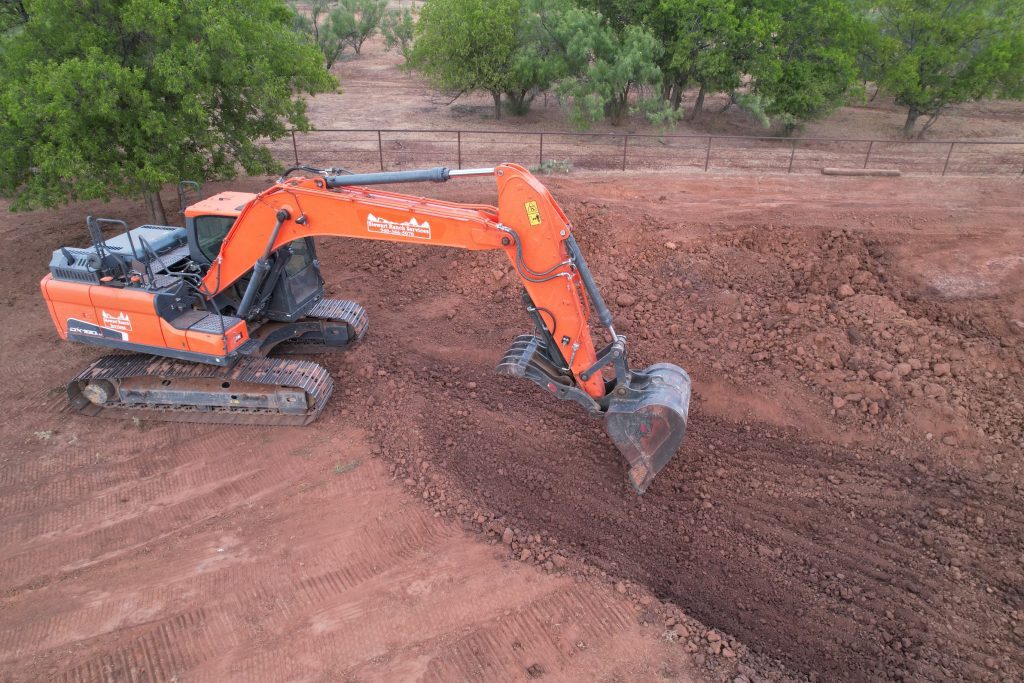
Environmental considerations play a pivotal role in the execution of construction projects. These include land clearing, the management of soil erosion, compliance with water regulation procedures, meticulous grading plans, careful monitoring of air quality, waste disposal strategies, and the protection of existing habitats. Additionally, it’s essential to take into account any archaeological findings associated with the project site.
By bearing these considerations in mind, construction projects can align with local regulations, minimizing their environmental impact. Moreover, this approach assists in mitigating noise levels and maintaining vibration levels within acceptable limits during excavation work.
In sum, it ensures that construction proceeds without causing disruption or long-term environmental and cultural repercussions.
Erosion and Sediment Control
When it comes to excavation services in Beaumont, Texas, one cannot overlook the importance of implementing effective erosion and sediment control measures. These measures play a crucial role in limiting soil loss, ensuring water quality, and preventing debris from entering our waterways. From silt fences to sediment basins and traps, various strategies are employed to combat soil erosion while adhering to local and federal environmental regulations.
Proper planning is the cornerstone of success in this endeavor. By carefully planning and executing these measures, we not only protect the environment but also remain in compliance with the law.
Waste Management and Recycling
In any excavation project, the efficient and responsible management of waste materials plays a pivotal role in reducing its environmental impact. It is crucial to segregate waste materials for proper collection and then transport them for recycling or responsible disposal when recycling is not possible. This approach not only decreases landfill usage but also mitigates air and water pollution, contributing to the conservation of valuable resources.
A fundamental aspect of effective waste management involves the systematic categorization of waste, followed by its collection from designated areas for reprocessing through recycling methods whenever applicable.
For non-recyclable items, it is essential to identify suitable receptacles that prevent them from entering natural ecosystems, while still offering the opportunity to derive some value from these seemingly unusable residues.
Summary
The accomplishment of construction projects relies heavily on the meticulous execution of excavation services. Establishing a robust foundation and efficient drainage necessitates expertise in various aspects, including methods, tools, and safety precautions.
Engaging an experienced contractor with a commendable track record can make a substantial difference in the project’s outcomes. Environmental considerations are integral to Beaumont’s excavation services, involving erosion control, sedimentation management, and waste disposal.
By meticulously planning and scrutinizing each stage, from conception to completion, your project can construct enduring foundations, ensuring long-term stability.
Frequently Asked Questions
What does excavation mean in construction?
In Beaumont, excavation services significantly enhance the construction prowess by their essential presence. From soil excavation to tunnel creation, these activities form the backbone of a strong foundation. This foundation, in turn, supports the successful execution of projects within designated timelines and financial parameters, making excavation services in Beaumont a linchpin in the construction ecosystem.
What is the meaning of re-excavation?
Re-excavation, the act of revisiting and digging up an archaeological site, is a valuable scientific endeavor. By unearthing additional artifacts, researchers enhance the knowledge gained from previous studies, adding layers to known discoveries.
What is excavation used by?
Construction projects hinge on the essential task of excavation, encompassing the movement of soil, rock, and materials. Builders employ a variety of tools and techniques to execute this crucial step efficiently. The process includes the disposal of unnecessary dirt, coupled with accurate measurement and recording of artifact locations. A detailed inspection precedes construction efforts, identifying elements that require removal or alteration.
What are the various excavation methods used in construction projects?
The most popular excavation techniques used for construction projects involve cut and fill, trenching, as well as dredging. These processes are crucial in order to create structures that will meet the objectives of a given construction project.
Stewart Ranch Services is the company you are looking for for your Beaumont excavation service project. Contact us for a free estimate and free inspection!
